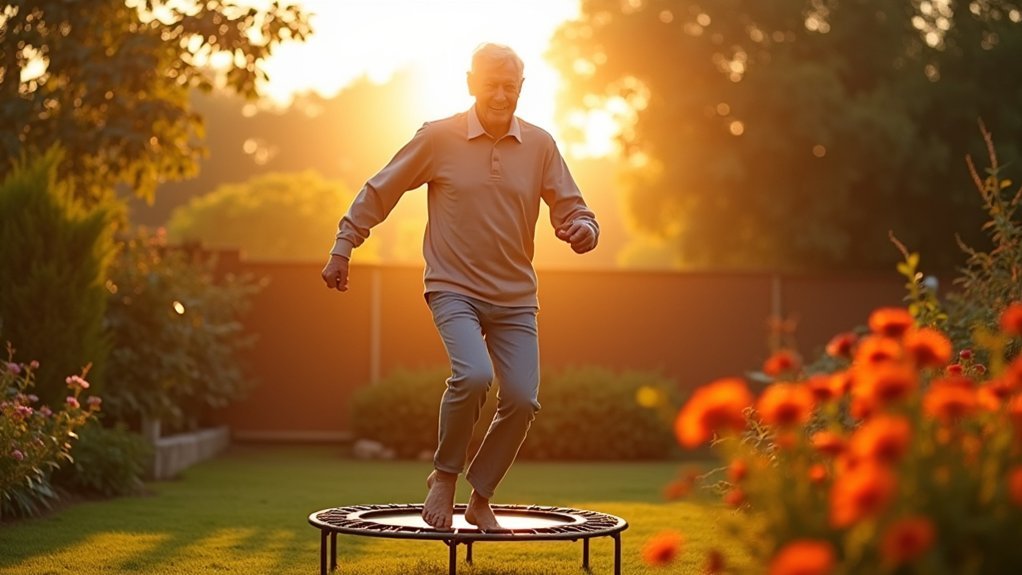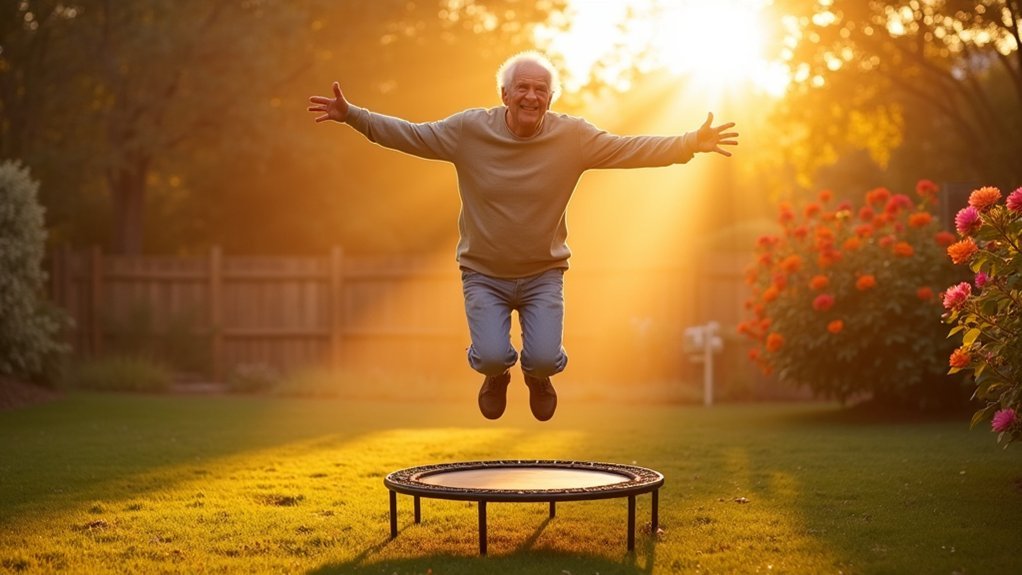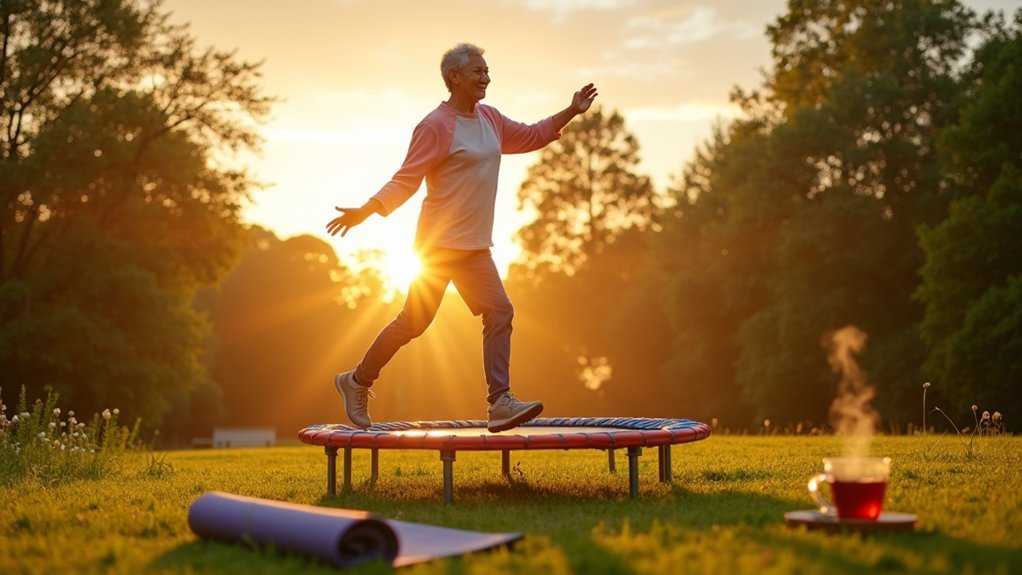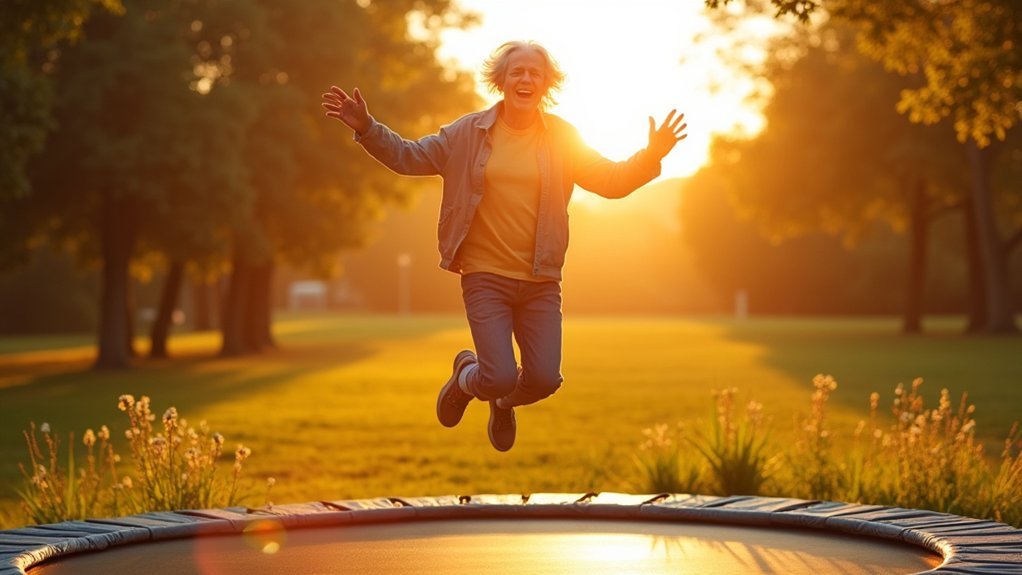“Sunrise Bounce” is a gentle morning rebounding routine that can transform your senior wellness. You’ll strengthen your core, improve balance, and boost circulation with just 5-15 minutes of low-impact bouncing on a mini-trampoline. The elastic surface absorbs up to 87% of impact force, making it joint-friendly while enhancing cognitive function and mood. Start with chair support if needed and gradually build your confidence. The morning ritual ahead will revitalize your entire day.
Why Morning Rebounding Transforms Senior Health

When seniors incorporate gentle rebounding into their morning routine, they access a powerful cascade of health benefits that extend far beyond simple exercise.
Those controlled bouncing motions simultaneously strengthen your core, improve balance, and sharpen proprioception—directly reducing fall risk while building movement confidence.
Each gentle bounce builds the confidence seniors need to move securely through their world, reducing fall risks with every rebound.
The gentle cardiovascular stimulation kickstarts circulation, delivering oxygen-rich blood throughout your body and enhancing lymphatic drainage.
This circulatory boost extends to your brain, increasing alertness, focus, and cognitive function right when you need it most. The health bounce technique serves as an excellent foundation for beginners to master proper form while still gaining significant benefits.
You’ll also experience measurable blood pressure regulation as your vessels maintain elasticity through consistent morning sessions.
Best of all, these 10-minute rebounds fit perfectly with morning energy peaks, establishing a consistent routine that positions you for healthier choices all day.
The Science Behind Low-Impact Bouncing for Older Adults
Unlike traditional exercises that strain aging joints, rebounding delivers its remarkable benefits through a unique scientific mechanism perfectly suited for senior bodies. When you bounce, your body experiences controlled gravitational changes that strengthen muscles without harsh impact.
Research confirms this gentle approach yields powerful results. The mini-trampoline’s elastic surface absorbs up to 87% of impact force, protecting your joints while still engaging multiple muscle groups. This creates a dual benefit: you’re building strength and improving balance simultaneously.
Studies show seniors experience up to 35% improvement in balance after just 14 weeks of rebounding. The constant micro-adjustments your body makes activate your proprioceptive system, enhancing your awareness of body positioning. This low-impact exercise is particularly beneficial for seniors concerned about joint strain.
This translates directly to improved coordination and reduced fall risk in everyday activities.
15-Minute Sunrise Rebounding Sequence for Beginners

Start your rebounding journey with safety measures like a stability bar and comfortable positioning on the trampoline.
You’ll find more enjoyment and longevity in your practice when you prioritize proper form over intensity or height of bounces.
Remember that small, consistent improvements in your minute sequences matter more than perfection, especially as your body adapts to this new movement pattern.
This workout emphasizes the importance of maintaining rhythm with music while progressing from basic movements to more complex combinations throughout the exercise routine.
Safety First Approach
Before starting your sunrise rebounding journey, ensuring proper safety measures can make all the difference between an invigorating morning ritual and an unwanted injury.
Consult your doctor before beginning this new exercise routine, especially if you have existing health conditions.
Always place your rebounder on a flat, non-slip surface and keep a sturdy chair nearby for balance support.
Wear supportive athletic shoes that fit properly to protect your joints during bouncing movements.
Start with gentle bounces, avoiding extreme movements that could strain your body.
Monitor how you feel in different temperatures—rebounding indoors may be safer during extreme weather.
Remember to hydrate before and after your session, and never push through pain.
Begin with just 5 minutes daily, gradually increasing as your balance and strength improve.
Aim to build up to 150 minutes weekly of your rebounding activity for optimal health benefits.
Progress Not Perfection
Consistency trumps intensity when you’re beginning your sunrise rebounding journey.
Don’t pressure yourself to perfect complex moves right away – your body needs time to adapt to this new form of movement. Start with Lindsay’s 10-minute routine and gradually increase duration as your stamina builds. Remember to maintain proper posture throughout all exercises, keeping a slight bend in your knees and your weight distributed through your feet.
- Celebrate small victories – Did you bounce for one minute longer today? That’s progress worth acknowledging!
- Track your journey – Notice how your balance improves week by week, how stairs become easier to climb, or how your morning stiffness diminishes.
- Join the community – Connect with fellow senior rebounders online who understand exactly where you’re starting from and can cheer your progress.
Safety Precautions and Modifications for Limited Mobility
Safety should always come first when you’re starting a rebounding routine, so speak with your doctor before beginning any new exercise program.
If you have mobility challenges, try chair-based adaptations like seated marches or gentle arm movements that still provide circulation benefits without balance risks. Maintain a hip-width stance for optimal stability when performing standing exercises on your mini-trampoline.
Prevent falls by removing trip hazards, wearing supportive shoes with good traction, and keeping a sturdy chair nearby as a support option during your morning ritual.
Chair-Based Exercise Adaptations
While pursuing an active lifestyle remains essential for seniors, adapting exercises to accommodate limited mobility guarantees everyone can participate safely and effectively.
Always begin with a sturdy chair that provides proper back support, and consult your healthcare provider before starting any new routine.
- Enhance Your Challenge: Add resistance with simple household items – slip on supportive shoes for seated marches, secure light ankle weights to intensify leg exercises, or use resistance bands to transform basic arm movements into strength-building repetitions. Maintaining a straight back while seated with feet flat on the floor helps ensure proper form and maximum benefit from each exercise.
- Protect Your Body: Start with shorter sets, monitor your heart rate, and hydrate regularly throughout your session.
- Track Your Journey: Document your progress daily to witness improvements in strength, flexibility, and confidence while maintaining consistent practice.
Fall Prevention Strategies
Because even a minor fall can lead to serious health complications for seniors, implementing effective prevention strategies remains crucial for maintaining independence and confidence.
Start by clearing your home of tripping hazards like loose rugs and clutter. Install grab bars in your bathroom and make sure pathways are well-lit and wide enough for mobility aids.
Your footwear matters—choose non-skid shoes with firm soles. If you use a cane or walker, verify it’s properly fitted and maintained.
Balance-focused exercises like Tai Chi can greatly reduce your fall risk. Talk to your doctor about reviewing medications that might cause dizziness or affect coordination. Remember that one in four Americans age 65+ falls each year, making prevention a public health priority.
Consider a home safety audit to identify hidden hazards, and practice fall-safe techniques to protect yourself if you do lose balance.
Medical Clearance First
Before you begin any new morning energy ritual, consulting with your healthcare provider is a fundamental first step. If you have cardiovascular, metabolic, or renal conditions, medical clearance is essential before starting.
Even if you’re generally healthy but have been inactive, you’ll want to “start low and progress slow” to reduce injury risk. The ACSM recommends moderate-intensity activity for adults, which can be modified to suit your individual capabilities.
- Safety comes first – Your body deserves protection, especially if you haven’t exercised regularly in the past year or experience symptoms during physical activity.
- Personalized approach matters – Your morning ritual should respect your unique limitations, focusing on stability and balance.
- Everyday movements count – Taking stairs or manually opening doors can become meaningful parts of your exercise routine without overwhelming your joints.
Complementary Stretches to Enhance Your Rebounding Benefits
The right stretching routine transforms your rebounding workout from good to exceptional. Just 10 minutes twice weekly can greatly improve your flexibility and joint mobility, counteracting age-related stiffness that affects your rebounding form.
Focus on hip and pelvic stretches to lengthen your stride and improve balance during bounces. Don’t skip neck and back movements that protect your spine during rhythmic motion. These stretches increase blood flow, delivering oxygen to muscles while preparing your connective tissues for impact. Always remember to warm up first with 5-10 minutes of light aerobic activity before starting your stretching routine.
You’ll notice improved coordination as hamstring flexibility prevents compensatory back movements. Morning stretching also synchronizes your breathing with movement patterns, establishing mindfulness before you step on the rebounder.
The combination of hip openers, shoulder stretches, and calf extensions will enhance your stability and power during vertical motions.
Building a Sustainable Morning Routine That Sticks

Creating lasting habits requires more than just willpower—it demands thoughtful design and personal connection to your daily rhythm.
Establish consistent wake-up times to regulate your circadian rhythm, then build your routine around natural energy peaks. Group similar activities like hygiene and dressing to create efficient workflow sequences. Incorporating structured activities throughout your morning provides seniors with a sense of security and control against the uncertainties that come with aging.
- Spark joy through connection – Schedule morning check-ins with family or join breakfast meetups to combat isolation while reinforcing accountability.
- Nourish your mind first – Begin with brief mindfulness or gratitude practice instead of anxiety-inducing news to set a positive tone for your day.
- Start small, grow gradually – Introduce 5-minute activity swaps rather than overhauling your entire morning, tracking what works and adjusting weekly.
Frequently Asked Questions
How Much Does a Quality Rebounding Mini-Trampoline Cost?
You’ll spend £40-£100 for basic rebounders, £100-£200 for mid-range models with better stability and padding, or £200+ for premium options with bungee cords and extensive warranties. Quality increases with price.
Can Rebounding Help With Specific Conditions Like Arthritis or Osteoporosis?
Yes, rebounding can help you manage arthritis by reducing joint pain and improving mobility. It’s also effective for osteoporosis, as studies show it increases bone density with just three 30-minute sessions weekly.
Is Rebounding Safe After Joint Replacement Surgery?
Rebounding can be safe after joint replacement, but you’ll need your doctor’s approval first. It’s low-impact, places less stress on joints than walking, and should be introduced gradually with proper safety precautions.
How Does Rebounding Compare to Water Aerobics for Seniors?
Water aerobics offers more joint protection than rebounding, though both benefit seniors. You’ll find water exercises ideal for arthritis, while rebounding provides convenient at-home workouts with good bone-strengthening benefits.
Can Rebounding Be Effective When Seated in a Chair?
Yes, you can enjoy effective seated rebounding by adapting techniques with resistance bands or specialized chair exercises. You’ll still strengthen your core, improve circulation, and reduce joint pain while maintaining safety and accessibility.
In Summary
You’ve now discovered sunrise rebounding’s incredible benefits for your golden years. With just 15 minutes each morning, you’re strengthening bones, improving balance, and energizing your day naturally. Remember to start slowly, incorporate your safety modifications, and pair with gentle stretches. Your consistent morning bounce routine isn’t just exercise—it’s a celebration of movement that’ll transform how you experience aging. Embrace the bounce!





Leave a Reply